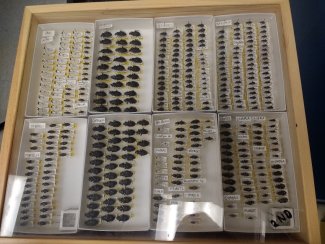Case Study
Studying Viruses Using Archived Rodent Samples
May 14, 2024
Most people would not appreciate receiving a carefully curated selection of frozen rodent poop. But Dr. Arvind Varsani is not most people.
A molecular virologist and professor in the School of Life Sciences and the Biodesign Institute at Arizona State University (ASU), Varsani is interested in virus diversity at many scales and across species. He collaborated with Laura Steger and Dr. Kelsey Yule at the NEON Biorepository at ASU, along with other researchers, to explore the potential of extracting viral DNA from archived rodent fecal and liver samples.
Their work was published in Virology: “Using Archived and Biocollection Samples Towards Deciphering the DNA Virus Diversity Associated with Rodent Species in the Families Cricetidae and Heteromyidae.”
Building a Catalog of Rodent Viruses
Rodents—like all living things—host an abundance of viruses, most of which have never been identified, sequenced, named, or cataloged. A few, such as hantavirus and lymphocytic choriomeningitis virus (LCMV), are zoonotic, meaning they are pathogens that can be transmitted to humans (or vice versa). Others cause diseases in other animals or in the rodents themselves. But the majority of viruses carried by humans and other animals do not cause disease, and some are actually beneficial (such as bacteriophages that kill harmful bacteria). For obvious reasons, most research has been focused on viruses that cause disease.
Varsani’s interest in viruses is much broader. “We’re not interested in whether it causes disease or not; we just want to know what is there,” he explains. “It is purely a curiosity-driven approach. Just as Darwin collected and cataloged various plant and animal species on his journeys, we want to collect and catalog viruses.”
Modern genetic sequencing technologies allow virologists like Varsani to do just that. Varsani and his study coauthors sequenced genomes for circular viruses (viruses with genetic material that forms a closed loop) found in rodent livers and fecal samples from the NEON Biorepository and other biocollections. The study was designed in part as a proof-of-concept to demonstrate that usable viral DNA can be extracted from cryogenically frozen samples. Varsani says, “We wanted to learn what kinds of viruses we could identify in these types of samples, because you do get degradation taking place with certain kinds of viruses. We wanted to see first, can we use archived material for this kind of study? And then, can we get complete genomes of viruses so we can start to classify them and see how they are structured?”
The answer to both questions turned out to be yes. Varsani and his team found and sequenced 346 distinct circular viral genomes from the archived samples, 93% of which represent new species of viruses. Roughly 83% of them are microviruses: small, non-enveloped viruses with a single-stranded DNA genome. The sequenced viruses come from a small number of samples collected in Arizona and New Hampshire by the NEON program and other researchers. Once the complete viral genome is sequenced, researchers can use the genetic information to classify each species into taxonomic categories. This classification can provide insights into how viruses are related and how they are evolving over time.
One interesting finding from the study is that many of the sequenced viruses belong to a group of viruses that infect Giardia, a genus of protozoan parasites that infect many kinds of mammals and typically sit in the liver. This type of genomic analysis could provide insights into the prevalence of Giardia in different ecosystems.
This work will help virologists identify patterns in the data and monitor emerging viruses. While most viruses are not pathogenic, new diseases can emerge from small mutations in an existing virus. When that happens, having a broad catalog of viruses can help epidemiologists trace the origins and evolutionary pathways of the disease, which can lead to faster response and better public health recommendations.
For now, Varsani is happy to have evidence that cryogenically frozen specimens can provide such rich genomic data for viruses. He continues to expand his partnerships with other researchers to identify and catalog viruses in more species (including scorpions) and more locations.
Why Biocollections Matter
The study depended on the availability of preserved biological specimens from the NEON Biorepository and researcher-hosted archives. Bio archives like the NEON Biorepository provide a critical source of specimens that can be used for many different types of studies.

A meticulously pinned beetle collection from our HARV site.
“Having a biorepository with preserved specimens opens up a huge number of doors to different types of research,” explains Laura Steger, the Environmental and Zoological Collections Manager for the NEON Biorepository at ASU. “NEON field researchers record a lot of data on small mammals at the time of capture, including species identification, age, reproductive condition, and body measurements, which are all really interesting and useful for specific types of studies. But there’s so much more to learn about that animal, both on the outside and on the inside. We’re preserving tissues that allow people to do virus research, as well as research in other areas of the microbiome. We’re collecting the actual parasites from these animals. We have researchers who have requested rodent teeth in order to reconstruct the historical migrations of caribou in Alaska using isotope analyses. So, you really have an incredible amount of research possibilities within a single archived individual.”
Researchers can also be an important source of archived samples; Varsani fosters collaborations between scientists to support research into viral outbreaks as well as other investigations. However, it can be time-consuming to locate and negotiate with the individual people who have the samples needed for a specific project. He says, “For example, we do not have a repository like this for samples from the Antarctic. So, if there is a major outbreak of something in, say, penguins or pinnipeds, I have to go knocking on people’s doors and ask if they have any samples lying around in their freezer.”

A technician handles samples at the NEON Biorepository at Arizona State University.
The availability of physical specimens dating back years or decades can be critical for epidemiology research. “Think about the pandemic,” Varsani says. “If we had a biorepository of bat samples going back several years, we could sequence viruses from various locations and identify the most closely related viruses and determine when they were circulating around. Then, we can start building models based on that data and reconstruct the history. It may turn out that there has been a ten-year period in which a new pathogen has been evolving before it first hits a human population.”
Vertebrate Samples at the NEON Biorepository
Field mouse on the forest floor in Domain 05, the Great Lakes
Varsani appreciated having access to well-documented and preserved samples from the NEON Biorepository. “I’ll be honest, academics are some of the most disorganized people, me included,” he admits. “I am not a cataloger. I’m a researcher. In my freezers, specimens are going to be in bags and freezer boxes which are hand-labeled. Whereas in the NEON Biorepository, everything is really well archived and well catalogued because that is what they do.”
For the virus study, Varsani worked closely with Steger and Kelsey Yule, the Project Manager for the NEON Biorepository. The project involved several phone calls to determine the best tissue types and preservation methods to support the research. Steger prepared the liver and gastrointestinal samples. Yule says the study is a great example of the type of work the NEON Biorepository supports. “Having that physical sample is the only way you can go back and collect different kinds of data that are not part of the original NEON design,” she says. “If NEON wasn’t archiving the samples, we couldn’t look at viruses like this.”
The NEON Biorepository is curated by Arizona State University and receives more than 100,000 physical samples from NEON field sites each year, including roughly 30,000 mammal-related samples (ear punches, hair/whiskers, blood, fecal samples, and whole voucher specimens) collected at terrestrial field sites. The Biorepository staff work with researchers to help them determine which samples will work best for their research and prepare the specimens. That often means preparing specific tissue samples as needed by the researcher.
Steger says, “We can support a lot of different researcher requests, such as pulling all kinds of different tissue samples and, often, preparing samples in a certain way. So, if they need to be preserved or fixed in a specific way, or if a DNA extract is needed from a specific voucher that we have, that’s something that we can do. We fulfill a lot of different types of loan requests, which is pretty exciting.”
Interested in checking out samples from the NEON Biorepository?
Researchers can request loans for non-destructive use or, in some cases, samples for destructive or consumptive use. Read the Sample Use Policy to learn more, and check out the NEON Biorepostiory data portal to see what is available.
Contact the NEON Biorepository team at ASU to discuss your sample needs.


